Tags
Billy Holiday, blues, Charles Mingus, civil rights, Duke Ellington, Fela Kuti, Hugh Masekela, jazz, john coltrane, Max Roach, Michael Jackson, Miriam Makeba, music, Paul Robeson, politics, racism, social activism, social activists
Just one year ago -still controversy surrounds his life and death…
Michael Jackson was undoubtedly a talented and creative artist and one, through the media channels and marketing of the time, was able to communicate to a huge global audience.
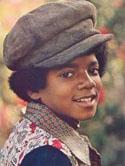
As a black artist he was also subjected to the racial bias and prejudice of the time and in his early years had to fight his corner (such as the attitudes of MTV). However his journey was made easier by being able to walk the paths that had already been cut by black musicians during the previous 50 years. This is one more debt that he owed.
We need to put his story into historical perspective and understand how other black musicians had put their careers and even their lives in jeopardy while fighting for basic rights as musicians and as human beings.
Music and other creative arts have always been used for people to express themselves and with African-Americans in particular the use of these media have not only been used to express their plight and discrimination but also as a way of describing their own personal identity.
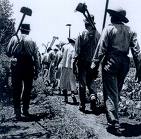
Starting with American enslavement, captured African slaves and their American descendants created work songs, spirituals, gospels, ragtime, jazz, blues, rhythm & blues, and contemporary rap and hip-hop .
Even the different forms of jazz (Dixieland, Swing, Bebop, Avant-garde, and Free Jazz) represent Black people’s struggle to determine a narrative about their existence in the world. Black music can be seen as a way of looking at the world, in the face of white supremacy and anti-Black racism. Jazz has always been creative, innovative, improvisational and often political.
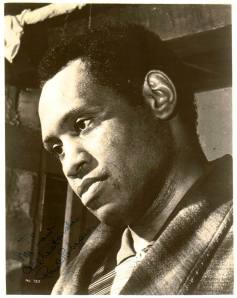
Paul Robeson
Let’ start with Paul Robeson, a true giant in many fields and who ‘ paid with his career for his principles’. Paul Robeson was a truly creative man. He was a singer, an actor, a national football player and a lawyer. Robeson achieved worldwide fame and recognition during his life for his artistic accomplishments, and his outspoken, radical beliefs which largely clashed with the colonial powers of Western Europe and the Jim Crow climate of pre-civil rights America. Robeson was a forerunner in the Civil Rights movement, a leader in the labor movement and a crusader in the anti-lynching movement. Because of his anti-colonialist sentiments, Robeson was investigated by both the CIA and the FBI.
“All that Paul Robeson stood for had enormous impact on American and global history. The combination of his art, intellect and humanity was rarely paralleled. The cruelties visited upon him by the power of the State stands as a great blemish on the pages of American history. But despite the attempt to wipe him from memory, he has endured and continues to influence. It speaks to our most strategic interests that African American children be instructed about the truth of his existence. Indeed it would be in the best interest of all Americans to know what this great patriot offered this nation.” –Harry Belafonte, April 9, 2008, on the occasion of Paul Robeson’s ‘110th’ Birthday
Billie Holiday
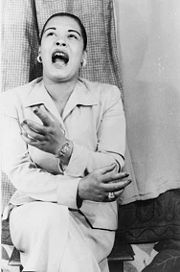
1949
Billie Holiday (born Eleanora Fagan Gough; April 7, 1915 – July 17, 1959) was the daughter of Clarence Holiday. Her father abandoned the family early and refused to acknowledge his daughter until after her first success.Billie Holiday incorporated the song “Strange Fruit” into her set list in 1939. Adapted from a poem, by a New York high school teacher, “Strange Fruit” was inspired by the 1930 lynching of two black men, Thomas Shipp and Abram Smith. It juxtaposes the horrid image of bodies hanging from trees with an description of the idyllic South. Holiday delivered the song night after night, often overwhelmed by emotion, causing it to become an anthem of early civil rights movements.
- Lyrics to “Strange Fruit:”
Southern trees bear strange fruit,
Blood on the leaves and blood at the root,
Black bodies swinging in the southern breeze,
Strange fruit hanging from the poplar trees.
Pastoral scene of the gallant south,
The bulging eyes and the twisted mouth,
Scent of magnolias, sweet and fresh,
Then the sudden smell of burning flesh.
Here is fruit for the crows to pluck,
For the rain to gather, for the wind to suck,
For the sun to rot, for the trees to drop,
Here is a strange and bitter crop.
On November 10, 1956, she performed before a packed audience at Carnegie Hall, a major accomplishment for any artist, especially a black artist of the segregated period of American history. She died in 1959 , with only$0.70 in the bank after she had been progressively swindled out of her earnings.
Many blues musicians suffered from racist attitudes and often sung about them as way of direct expression of their feelings as well as to raise awareness. This is from one of J.B.Lenoir’s songs:
- I never will go back to Alabama, that is not the place for me (2x)
- You know they killed my sister and my brother,
- And the whole world let them peoples go down there free.
- From “Alabama Blues”
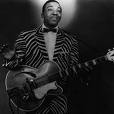
JBL
J. B. Lenoir (March 5, 1929 – April 29, 1967) was an African-American blues guitarist and singer/songwriter ,popular in the 1950s and 1960s.
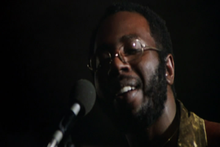
Mayfield is remembered for his introduction of social consciousness into R&B and for pioneering the funk style. Many of his recordings with the Impressions became anthems of the Civil Rights Movement in the 1960s, and his most famous album, Super Fly, is regarded as an all-time great that influenced many and truly invented a new style of modern black music (#69 on Rolling Stone’s list of the 500 greatest albums).
 James Brown is known as “The Godfather of Soul”, other times as “the hardest working man in show business”. He was a social activist as well as an all round artist.
James Brown is known as “The Godfather of Soul”, other times as “the hardest working man in show business”. He was a social activist as well as an all round artist.
As a prolific singer, songwriter, dancer and bandleader, Brown was a pivotal force in the music industry. He left his mark on numerous artists. Brown’s music also left its mark on the rhythms of African popular music, such as afrobeat, jùjú and mbalax,[4] and provided a template for go-go music.[5]
Many in the black community felt that Brown was speaking out to them more than some major leaders in the country, a sentiment that was strengthened with the release of his groundbreaking landmark single, “Say It Loud – I’m Black and I’m Proud“.
Brown continued performing benefit concerts for various civil rights organizations including Jesse Jackson‘s PUSH and The Black Panther Party‘s Breakfast program throughout the early-1970s. Brown also continued to release socially-conscious singles such as “I Don’t Want Nobody To Give Me Nothing (Open Up the Door, I’ll Get It Myself)” (1969), “Get Up, Get Into It, Get Involved” (1971), “Talking Loud and Saying Nothing” (1972), “King Heroin” (1974), “Funky President (People It’s Bad)” (1974) and “Reality” (1975).

Like Michael Jackson he had several personal problems that certainly did not make him a saint, but he did leave a legacy that deserves to be recognized.
Charles “Charlie” Mingus, Jr. (April 22, 1922 – January 5, 1979) was an American jazz bassist, composer, bandleader, and pianist. He was also known for his activism against racial injustice.
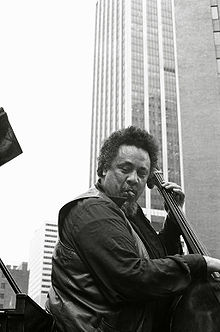
CM 1976
Charles Mingus was known for being angry and outspoken on the bandstand. That’s why, in response to the 1957 Little Rock Nine incident in Arkansas, when Governor Orval Faubus used the National Guard to prevent black students from entering a newly desegregated public high school.
Mingus displayed his outrage at the event by composing a piece entitled “Fables of Faubus.” The lyrics, which he penned as well, offer some of the most blatant and harshest critiques of Jim Crow attitudes in all of jazz activism.
Oh, Lord, don’t let ’em shoot us!
Oh, Lord, don’t let ’em stab us!
Oh, Lord, don’t let ’em tar and feather us!
Oh, Lord, no more swastikas!
Oh, Lord, no more Ku Klux Klan!
Name me someone who’s ridiculous, Danny.
Governor Faubus!
Why is he so sick and ridiculous?
He won’t permit integrated schools.
Then he’s a fool! Oh Boo!
Boo! Nazi Fascist supremacists
Boo! Ku Klux Klan (with your Jim Crow plan)
Two, four, six, eight:
They brainwash and teach you hate.
“Fables of Faubus” originally appeared on Mingus Ah Um (1959), although Columbia Records found the lyrics so incendiary that they refused to allow them to be recorded. In 1960, however, Mingus recorded the song for Candid Records, lyrics and all, on Charles Mingus Presents Charles Mingus
Odetta Holmes, (December 31, 1930 – December 2, 2008), known as Odetta, was an American singer, actress, guitarist, songwriter, and a human rights activist, often referred to as “The Voice of the Civil Rights Movement”.
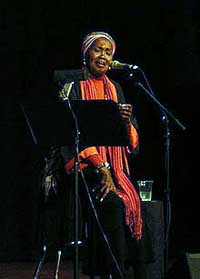
Odetta
Max Roach (January 10, 1924 – August 16, 2007) was an American jazz percussionist, drummer, and composer.
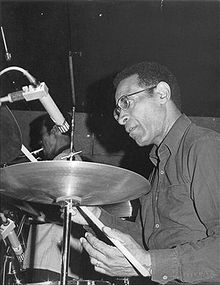
Max Roach
A pioneer of bebop, Roach went on to work in many other styles of music, and is generally considered one of the most important drummers in history. He worked with many of the greatest jazz musicians, including Coleman Hawkins, Dizzy Gillespie, Charlie Parker, Miles Davis, Duke Ellington, Charles Mingus, Sonny Rollins and Clifford Brown.
Roach also led his own groups, and made numerous musical statements relating to the civil rights movement of African-Americans. His famous composition”Freedom Now Suite” used a photo of black students at a whites-only lunch counter in the South on the album cover.
In African countries there have been many black musicians who have had to fight racism , prejudice and discrimination.
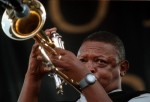
Since 1954, Masekela played music that closely reflected his life experience. The agony, conflict, and exploitation South Africa faced during 1950’s and 1960’s, inspired and influenced him to make music. He was an artist who in his music vividly portrayed the struggles and sorrows, as well as the joys and passions of his country. His music protested about apartheid, slavery, government; the hardships individuals were living. Masekela reached a large population of people that also felt oppressed due to the country’s situation.
Miriam Makeba (4 March 1932 – 10 November 2008) was a South African singer and civil rights activist. The Grammy Award winning artist is often referred to as Mama Afrika.
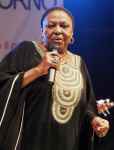
Her marriage to Trinidadian civil rights activist and Student Non-violent Coordinating Committee leader Stokely Carmichael in 1968 caused controversy in the United States, and her record deals and tours were cancelled.

Fela Anikulapo Kuti (15 October, 1938 – 2 August, 1997), or simply Fela, was a Nigerian multi-instrumentalist musician and composer, pioneer of afrobeat music, human rights activist. HMV ranked him #46 on a list of the top-100 most influential musicians of the 20th century.
Not to forget the many other artists who had to make their way against the odds –
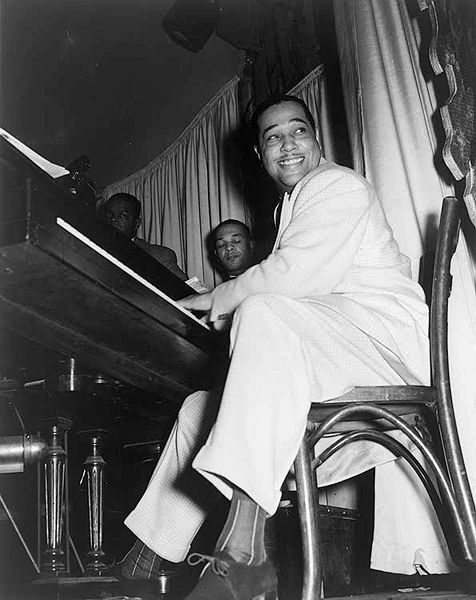
Duke Ellington 1943
In a 1944 New Yorker profile of Duke Ellington, Richard Boyer told of a white St. Louis policeman enthusiastically greeting Duke Ellington after a performance, saying: “If you’d been a white man, Duke, you’d have been a great musician.”
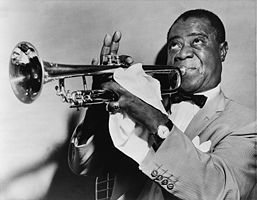
Louis Armstrong
“Once the whites who played it and the listeners who loved it began to balk at the limitations imposed by segregation, jazz became a futuristic social force in which one was finally judged purely on the basis of one’s individual ability. Jazz predicted the civil rights movement more than any other art in America.” (Stanley Crouch)
.
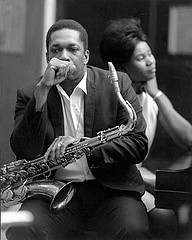
John Coltrane
and what about ….”Stand up for your Rights…”
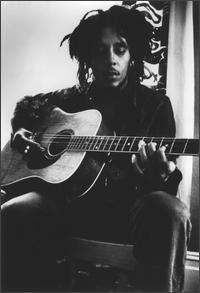
Bob Marley

Rock on Michael.
Raven
http://cherokeebydesign.wordpress.com/